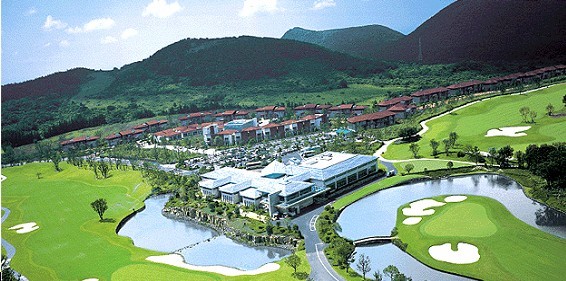Country clubs in economic sand trap
A growing number of golf clubs faces financial crisis
By Korea HeraldPublished : Nov. 26, 2013 - 19:50

Koreans are avid golfers and the numbers prove it. According to the Korea Golf Course Business Association, more than 18 million golfers visited the nation’s golf courses last year.
The number reflects a continuous upward curve starting from 1983 when the organization first began to collect data on the Korean golf industry.
Since then, not once has the number of golfers decreased. The same goes for the number of golf courses, with the figure reaching 248 last year, more than 10 times the number back in 1983.
Despite the steady growth, there seem to be some concerns about a so-called golf fatigue amid an ongoing economic slump.
“The business is definitely not as hot as it used to be, particularly in the early 2000s when people lined up to become members,” said Lee Jong-gwan, a spokesman for the Golf Course Business Association.
Nationwide, up to 20 country clubs operating golf courses have registered for court receivership as of this month, industry sources said.
Further, there is a monthly average of 100 lawsuits in which golf course members demand the return of their initiation fees, with the requests involving 7 trillion won.
Most golf courses refund the initiation fees ― also called down payments ― when the contract for using the facilities expires, usually after five years.
The problem with the struggling country clubs is that they don’t have the money for the refunds, leading to lawsuits.
The number reflects a continuous upward curve starting from 1983 when the organization first began to collect data on the Korean golf industry.
Since then, not once has the number of golfers decreased. The same goes for the number of golf courses, with the figure reaching 248 last year, more than 10 times the number back in 1983.
Despite the steady growth, there seem to be some concerns about a so-called golf fatigue amid an ongoing economic slump.
“The business is definitely not as hot as it used to be, particularly in the early 2000s when people lined up to become members,” said Lee Jong-gwan, a spokesman for the Golf Course Business Association.
Nationwide, up to 20 country clubs operating golf courses have registered for court receivership as of this month, industry sources said.
Further, there is a monthly average of 100 lawsuits in which golf course members demand the return of their initiation fees, with the requests involving 7 trillion won.
Most golf courses refund the initiation fees ― also called down payments ― when the contract for using the facilities expires, usually after five years.
The problem with the struggling country clubs is that they don’t have the money for the refunds, leading to lawsuits.

“Our parent company is in a tight financial situation, which means we won’t have enough to pay back the down payments,” said one manager at a country club in Gangwon Province. He declined to be identified.
Those in Gyeonggi Province, located closer to Seoul, are in better shape, he added.
But the situation is not all bad, according to industry insiders.
“We believe the industry will undergo a facelift, if you will, to sort things out and revamp the golfing culture,” said Lee of the Korea Golf Course Business Association.
As Lee and other managers of local country clubs point out, in the past ― particularly in the late ’90s and early 2000s when the sport first started to pick up ― many considered membership as an investment.
Now, they say the culture is changing so that it’s more about people wanting to actually enjoy the sport.
“The face value of my membership has been more than halved but I’m happy because, from the beginning, I had purchased the contract to get booking priority and discounts,” said Lee Mi-myung, a housewife who is a member of Duck Pyung Hillview Country Club.
Nevertheless, concerns linger that the local golfing scene may face the same kind of fate as in Japan, where half of the nation’s country clubs went bankrupt during the “lost 10 years” of the local economy.
“If too many country clubs go under, it would have a significant impact on the sector,” said Kim Kap-young, a manager at a country club in South Jeolla Province.
By Kim Ji-hyun (jemmie@heraldcorp.com)
Those in Gyeonggi Province, located closer to Seoul, are in better shape, he added.
But the situation is not all bad, according to industry insiders.
“We believe the industry will undergo a facelift, if you will, to sort things out and revamp the golfing culture,” said Lee of the Korea Golf Course Business Association.
As Lee and other managers of local country clubs point out, in the past ― particularly in the late ’90s and early 2000s when the sport first started to pick up ― many considered membership as an investment.
Now, they say the culture is changing so that it’s more about people wanting to actually enjoy the sport.
“The face value of my membership has been more than halved but I’m happy because, from the beginning, I had purchased the contract to get booking priority and discounts,” said Lee Mi-myung, a housewife who is a member of Duck Pyung Hillview Country Club.
Nevertheless, concerns linger that the local golfing scene may face the same kind of fate as in Japan, where half of the nation’s country clubs went bankrupt during the “lost 10 years” of the local economy.
“If too many country clubs go under, it would have a significant impact on the sector,” said Kim Kap-young, a manager at a country club in South Jeolla Province.
By Kim Ji-hyun (jemmie@heraldcorp.com)
-
Articles by Korea Herald



















